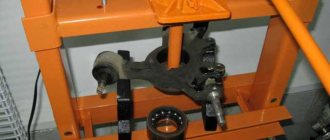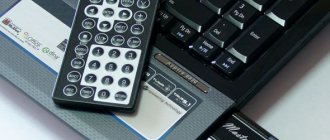With the help of simple techniques, you will be able to configure and retrofit your laptop, after which it can be used as a server for creating and storing backup copies of data, a torrent client with 24x7 operation, and a network video recorder.
Streaming data: the video is stored on the server and played via a local network on a smartphone or tablet. And it's all very simple! All you have to do is turn your old laptop into a server by following our simple tips. Don't rush to send your old laptop to the landfill: it can be useful as a home server. Using simple techniques, you will be able to adapt your computer to continuous operation and install the appropriate software, the capabilities of which exceed the functionality of a NAS.
Old laptops in most cases do not have enough computing power, but for server tasks it is more than enough. It is much more important to have a high-speed interface such as eSATA, FireWire or Gigabit Ethernet. Laptops equipped with rather power-hungry desktop processors or devices with a USB 1.0 interface (manufactured before 2002) are not suitable for this.
The laptop can be installed in any cool, ventilated place, since the server can be controlled from a distance. The fastest and most reliable way to connect a laptop to a router is a network cable. If you plan to use a printer on the network, it must be connected directly. To use it as a digital video recorder, the laptop requires a DVB-T digital receiver or an antenna connector.
Increasing disk space
One of the most important conditions for the operation of a home server is sufficient disk space. But on older laptops it is often quite limited. This means that you need to add a reliable storage device to your laptop. You can, of course, replace the old hard drive with a new one with a capacity of up to 750 GB. But this entails the need to reinstall the operating system and programs. Therefore, we recommend connecting an external hard drive.
STORAGE: 2.5 OR 3.5 INCH?
The advantage of 2.5-inch hard drives is their compactness and noiselessness, as well as the absence of a power supply. When the home server goes into standby mode, they turn off and do not consume power. However, their capacity is no more than 1 TB, and they are relatively expensive. Larger 3.5-inch models at similar prices have more capacity, but they require a power supply that drains power even in standby mode. In short, for those who need a drive with a capacity of at least 1 TB for constant use, we recommend choosing a 3.5-inch hard drive, otherwise a 2.5-inch model is sufficient. When purchasing, you also need to pay attention to the interface used, since there are significant differences in speed between them.
WHICH INTERFACE IS BETTER?
Any laptop suitable for working as a server is equipped with USB 2.0 ports. But this old standard, with a throughput of about 25 Mbps, will bottleneck an external hard drive with four times the data transfer speed. However, depending on the type of home network, USB 2.0 speed may be quite sufficient. For example, if your router or laptop is not connected via Gigabit Ethernet, they can only communicate at 12 Mbps. The speed of information exchange between computers connected in a wireless local network is also low - up to 20 Mbit/s. However, if you do not regularly have to “drive” many files of several gigabytes in size across the network, these figures are quite acceptable.
If your laptop is equipped with an ExpressCard slot, you can connect a controller with USB 3.0 ports to it. Even though the laptop is equipped with USB 2.0 ports, when purchasing a hard drive, you should choose a model with USB 3.0. It can be quickly filled with data from a modern PC, and then connected to a laptop that functions as a server. If you work with a gigabit network and plan to store high-definition video on your home server, USB 2.0 will not suit you due to its low bandwidth. Therefore, if possible, use an eSATA or FireWire hard drive if your laptop has one of these interfaces. If you have an ExpressCard slot, you can connect a controller with two USB 3.0 ports, and to it a hard drive that supports the high-speed standard.
Introduction
It all started with the fact that we needed to go to another city to record sound for a film, and the money... well, well, you know. The only ADC of suitable quality that we were able to purchase at a reasonable cost was an external (USB) sound card Creative Sound Blaster Surround 5.1
. But it required a computer. Naturally, there was no laptop either. And I really didn’t want to drag my desktop computer with me. I had to make a laptop with my own hands.
WINDOWS SETUP
Even in the lowest power mode, the processor power is sufficient for most server tasks. In the power settings, select the power plan with the lowest power consumption and set the “Standby mode after 20 minutes.” In the advanced settings, make sure that the laptop continues to work with the lid closed. If the laptop overheats, the lid will have to be opened. In Device Manager, open the properties of the network adapter and on the “Power Management” tab, enable the option “Allow the device to wake the computer from standby mode.”
NETWORK CONFIGURATION
To ensure that the server is always accessible via one IP address, assign it a static IP through the web interface of your router. To do this, you will need the MAC address of the laptop. To find it out, click on “Start|Run: cmd” and type “ipconfig –all” in the command line. The “Physical Addresses” line contains the MAC address of your laptop’s network controller. How to bind a static IP to a MAC address, read the documentation for the router, since for different models this setting may be in different sections of the menu.
REMOVING UNNEEDED PROGRAMS
To free up disk space and minimize potential security vulnerabilities, you should uninstall any programs that you will no longer use.
File server and backup
Your new server can be used to store all copies of data from all devices on the network. Create a “Backups” folder on an external hard drive connected to it, and in it - subfolders for each network computer. Share the directory: by right-clicking on it, select “Properties” and the “Access” tab. To get started, the default settings will be enough.
On client PCs, find the created network folder in Explorer by entering “[Server computer name][Shared folder name]” in the address bar. If you regularly create backups, it is recommended to connect this folder on the client PC as a network drive. To do this, in the “client” Explorer, click on “Service | Map a network drive" (in Windows Vista and 7, open the menu bar by pressing "Alt"). In the top drop-down list, select the desired drive letter, and in the “Folder” field, specify the network path - for example, “homeserverworking_pc”. If the server remains on all the time, check the “Recover at logon” checkbox so that the network drive is automatically mapped and displayed in Explorer.
Use for distributed computing
The last thing you can do with an old computer is use it for distributed computing . There are many projects out there that happily use your computer's processing power to solve the complex problem of data analysis for the benefit of humanity.
A great example of this is the BOINC project, which uses computers in people's homes to process the data needed to solve complex scientific problems. Such analysis often requires an absurd amount of computation, so problems are broken down into tiny pieces and distributed across computers around the world.
This is very easy to do because once you have the BOINC app up and running on your PC or Mac, you can simply leave it running in the corner without even connecting a keyboard, mouse or monitor. It will work automatically, communicating with BOINC servers and performing calculations. It will use some electricity, but the processing power is incredibly valuable in terms of being able to solve serious problems.
CREATE BACKUPS ON YOUR HOME SERVER
On a network drive prepared in this way, you can save backups using familiar software - for example, using the Windows “Data Backup” function. More efficient is the Unison network solution, which runs simultaneously on both the server and client PCs and ensures fast data synchronization.
Copies of data in the cloud
Cloud backup Home server stores files using Dropbox in online storage Since the home server can work at night, it has enough time to synchronize its data and client computer backups with cloud storage. Those who use the Dropbox service can, using special software, integrate it with their home server, connecting it as a network drive, and organize a synchronization schedule for specified folders. If you use the SkyDrive service, which is part of the Windows Live services category, you will need to download the Windows Live Mesh program from the project website and select the folders to synchronize when starting. After this, the home server will store important data in the cloud every day.
Remote download management
A home server in the form of a full-fledged PC outperforms any network-attached storage system when it comes to downloading content (to or from the network). The fact is that a specialized network HDD can only perform downloading operations specified by the manufacturer, while a laptop-based home server can cope with tasks related to data transfer in both directions. You can add a task to download a file over your home network and beyond using the TeamViewer program. After that, it will run on its own without requiring your attention.
If you don't want the download processes on your home server to affect the connection speed on other computers, you need to make some settings. On top router models, you can assign a priority to each device on the network. If your router does not have such functions, then you can configure each program that creates a load on the network connection. For example, you can select night time for backup, and for torrent clients you can limit the upload and download speed and configure it depending on the time of day.
How to connect a laptop and computer using third-party programs
Is it possible to use a laptop as a monitor simply by using a utility from the Internet? - Can! Most likely, you have heard about a program such as TeamViewer and its analogues, often used to establish communication between two devices. Also, products with MacOs operating systems often already have a built-in AirDisplay application, but you can install it yourself if it is missing.
Important! Air Display is more aimed at dividing the display and using the laptop as a second monitor than at fully broadcasting the image. This option may be suitable for you if you have insufficient resolution, but it will not be a full replacement for it. The program also belongs to the paid category and its cost is quite high (~ 700 rubles)
SOFTWARE FOR DOWNLOADING DATA TO AND FROM THE NETWORK
You can carry out long-term downloads using the JDownloader program. For most network tasks, any browser will do. In addition, free programs for downloading data may be useful: FileZilla, μTorrent and JDownloader.
Home server as a print center
Printers connected to your home server can also be shared. Thus, you can send documents for printing from any computer on your home network, including via a wireless network connection. To do this, you need to connect the printer to the server and install the drivers. Right-click to share your printing device and connect it to all client PCs as a network printer by selecting Devices and Printers (Windows Vista and 7) or Printers and Faxes (Windows XP). If the home network client does not find the drivers, download them from the manufacturer's website, extract the executable INF file, and specify the directory where it is located in the Windows Installer dialog box.
Streaming media
Modern TVs and Blu-ray players play AVI and MKV files. It is most convenient when they are played directly from a home server via the network. This requires UPnP-enabled server software that searches for media files in your home storage and makes them available to client PCs. But keep in mind that the UPnP standard is not well developed, which sometimes leads to compatibility issues.
Ways to connect a laptop as a monitor
According to the mechanism of their operation, both devices are almost identical, so connecting them with each other will not be difficult. It is also important to note that it is impossible to connect a laptop computer to the system unit to broadcast an image, just as you would not try to connect a system unit; it will still perceive the third-party device as additional memory.
Therefore, in order to install a laptop computer instead of a monitor, we will have to go in other ways. There are two ways to do this:
- Cable connection(HDMI, DVI, VGA)
- WI-FI
How to connect a laptop screen to a computer? Depends on what is more convenient for you. For the first two you will need an appropriate connector and cable, for the second - a stable Internet connection.
Reference! Using most of the methods listed below, you can also broadcast the image to the display of any of your mobile devices.
INSTALLING UPNP SERVER
In most cases, optimal compatibility is achieved by installing software from the manufacturer. For example, for Blu-ray players and Samsung TVs there is an Allshare UPnP server. Free UPnP servers such as TVersity sometimes have compatibility issues with end devices. As an alternative, you can use the PS3 media server, which is designed to work with game consoles acting as clients. In the program settings dialog box, you must specify in which directories it should search for multimedia data. Once the setup is complete, the home server will be available in the menu of all network devices that support UPnP. To organize streaming to your mobile gadget, install a player on it that supports UPnP - YXPlayer for iOS or UPnPlay for Android.
Recording and broadcasting TV shows
A home server is capable of continuously recording and broadcasting TV shows over a local network. A constantly turned on computer provides an excellent opportunity to use it as a video recorder. This requires only a TV tuner with a USB connection interface, the software of which is configured via TeamViewer. The folder in which recorded programs will be stored must also be publicly accessible. Streaming of the current program is carried out through TV Scheduler Pro and the JTVLANServer plugin (available on DVD). Install TV Scheduler and configure it via the web interface (http:[home server IP address]:8420). Then install JTVLANServer on the home server and JTVLANClient on the client computer.
Remote control of home server
All home server functions that a laptop has can be controlled remotely using the TeamViewer program. The app will also allow you to view websites with Flash content on your iPad and iPhone.
Selection of components
I set myself three main goals.
Let's talk about choosing each component.
Matrix
Since the gadget is planned to be quite mobile, I decided that the matrix should be laptop-sized. Laptops use matrices with different types of connectors. Let's look at the main ones.
Panel Self-refresh is a technology with which the display displays a picture when there is no video signal and changes it at the request of the graphics processor.
eDP also supports the integration of additional digital packets into the video signal, which allows you to implement other interfaces on the display board. For example, you can add a microphone, webcam, touch surface, USB hub. This allows you to reduce the number of conductors in the cable to connect to the system board and reduce the cost of parts and maintenance.
Unlike LVDS, eDP reduces the total number of lines required to transmit data. And all without loss of quality and with clarity control!
In the next few years, I think the eDP standard will displace the outdated LVDS from the market. For clarity, I will provide a table comparing the technical characteristics of the interfaces.
Comparison of LVDS and eDP
Full HD matrices on the eDP interface are much lower in price than those with LVDS support. This also needs to be taken into account, but for me the choice was not so simple.
In the meantime, I settled on a 15.6-inch matrix diagonal.
Motherboard
Now you need to select the motherboard. It is she who will dictate her own rules for support (or lack thereof) of interface and other equally important connectors.
Main form factors of motherboards
To choose a motherboard, you need to decide on its form factor. Mini-ITX, Mini-STX and thin mini-ITX formats are best suited to a fifteen-inch matrix.
One of the most important options is that there must be an LVDS connector for connecting the matrix.
All the rest
Since the selected motherboard only had a 40pin LVDS connector, I decided to take the matrix with the same connector. I settled on the Innolux N156B6-L0B matrix with a diagonal of 15.6 inches.
I had fewer requirements for the processor: as long as it worked and was more powerful than mobile ones.
RAM - SO-DIMM DDR4, storage - SSD Sata M2 120 GB.
This was enough for the first test build.
CPU cooler
I researched the options first in local stores and later on Aliexpress, but I never found anything suitable.
In the options I found, I was not satisfied with the location of the heatsink and the bend of the heat pipes - I was going to place the motherboard in the case so that, firstly, the connectors were on the right side of the user, and secondly, the processor would be located closer to the top edge of the device . This will make cooling more efficient.
As a result, my choice fell on the Intel processor cooler, model BXHTS1155LP.
LVDS cable for connecting the laptop matrix and motherboard
Initially, I assumed that this cable could be borrowed from a laptop with an identical LVDS connector. I worked in a service department, and many laptops passed through my hands every day, but I was disappointed. Three years passed before I found an LVDS cable that suited my pinout.
When I had all the components, I began modeling the body.
SETTING UP THE TEAMVIEWER SOFTWARE
Install TeamViewer on the server and client computer and create an account in the program. To do this, click on the “My Computers” button located at the bottom right. Via the menu “Connection | Setting up uncontrolled access, give the server a permanent name and password, and it will appear in the My Computers list or on the encrypted website https://login.teamviewer.com after you log in. Double click to launch the remote control function. To copy files from or to the server, click the File Transfer button that appears at the top of the remote control window.
The most popular utilities for remote communication
- ZoneOS ZoneScreen.
- Radmin.
- TeamViewer.
- AirDisplay.
- Space desk
Such programs are divided into two types:
- Display mirroring (Space Desk) - you will simply mirror the image from the PC screen to the laptop screen, and with their help you can split the image on both devices (great for working separately with a separate application (Photoshop)).
- Utilities for remote PC control (TeamViewer) - with them you can not only broadcast the display of one device to another, but also completely control the system using the second device.
PLAYING FLASH VIDEO ON YOUR IPAD
Change the screen resolution of your home server to 1024x768 pixels, install the free TeamViewer program on your iPad and specify the account you are using for it. You can now control your home server from your tablet, including launching its browser and loading websites with Flash content. Performance will be sufficient for navigating through them and simple browser games. But while you can view Flash videos on your iPad, playback may experience slight delays depending on your network bandwidth. In addition, you will have to come to terms with the lack of sound. For specialists: the free FreeNAS system
Using FreeNAS OS, you can create a similar NAS system with a web interface. It can be run from a USB flash drive, and the hard drive can be used to store data. FreeNAS uses the ZFS file system, which offers powerful tools for creating OS snapshots similar to those created using Apple's TimeMachine program. FreeNAS offers all the features you need, but installation is complex.











